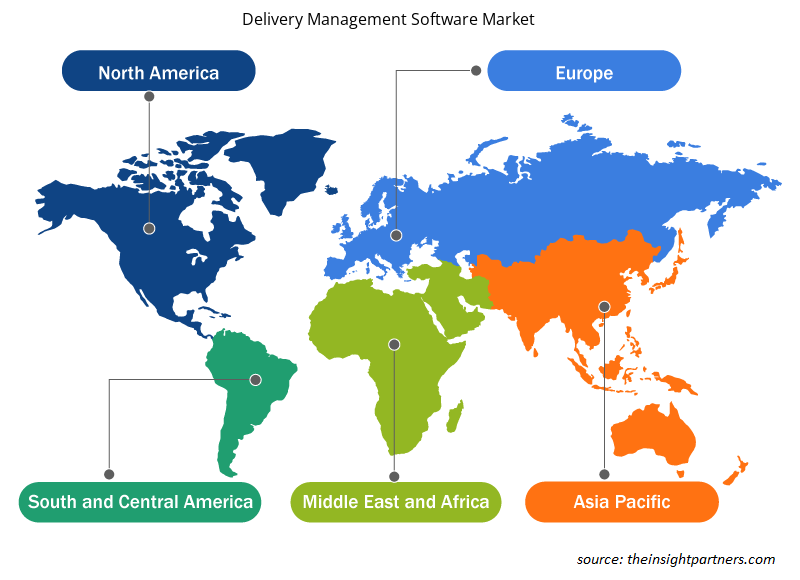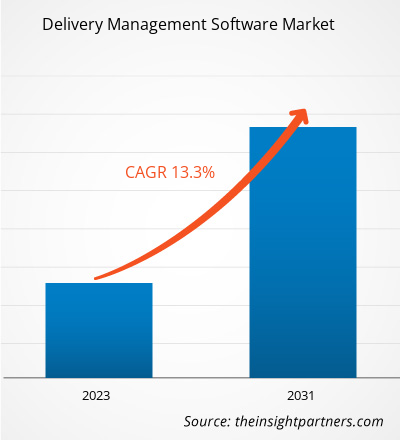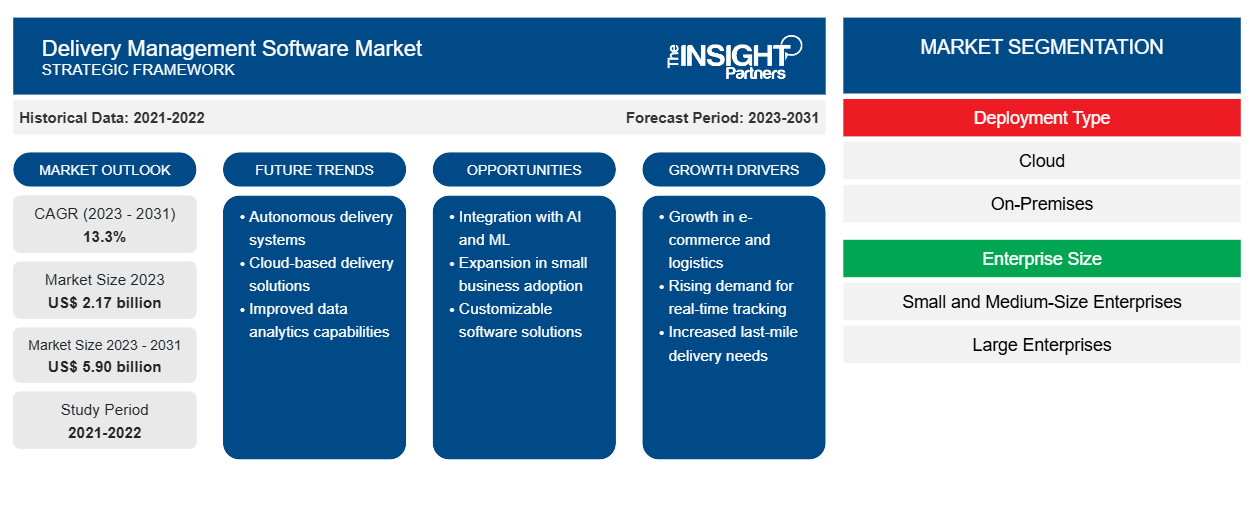Das Marktvolumen für Liefermanagement-Software soll von 2,17 Milliarden US-Dollar im Jahr 2023 auf 5,90 Milliarden US-Dollar im Jahr 2031 anwachsen. Von 2023 bis 2031 wird für den Markt eine durchschnittliche jährliche Wachstumsrate (CAGR) von 13,3 % erwartet.
Die Integration von KI- und ML-Technologien in die Liefermanagement-Software zur Verbesserung des Kundenerlebnisses wird wahrscheinlich ein wichtiger Markttrend für Liefermanagement-Software bleiben.
Marktanalyse für Liefermanagementsoftware
Der Markt für Liefermanagementsoftware wächst aufgrund der wachsenden E-Commerce-Branche und der steigenden Nachfrage nach Echtzeitinformationen zur Verwaltung von Logistik und Lieferketten rasant. Der Markt wächst stetig, angetrieben von der wachsenden Bevölkerung, der zunehmenden Digitalisierung und der Vorliebe der Verbraucher für Online-Shopping. Darüber hinaus bietet die wachsende Nachfrage der Endbenutzer nach Automatisierung lukrative Möglichkeiten für Marktwachstum.
Marktübersicht für Liefermanagementsoftware
Mithilfe von Liefermanagementsoftware können Sendungen verfolgt und eine pünktliche Zustellung von Artikeln an Kunden sichergestellt werden. Der Einsatz innovativer Liefermanagementsoftware bietet Unternehmen erhebliche Vorteile, darunter eine höhere Anlagenauslastung, eine höhere Kundenzufriedenheit und einen geringeren Kraftstoffverbrauch. Die Software verbindet den Zusteller und die Back-End-Büros auf einer einzigen Plattform und stellt die Informationen bereit, die ein Zusteller zur Zustellung eines Artikels benötigt. Die wachsende Nachfrage nach Echtzeitinformationen und verbesserter Lieferverfolgung beflügelt den Markt.
Passen Sie diesen Bericht Ihren Anforderungen an
Sie erhalten kostenlose Anpassungen an jedem Bericht, einschließlich Teilen dieses Berichts oder einer Analyse auf Länderebene, eines Excel-Datenpakets sowie tolle Angebote und Rabatte für Start-ups und Universitäten.
- Holen Sie sich die wichtigsten Markttrends aus diesem Bericht.Dieses KOSTENLOSE Beispiel umfasst eine Datenanalyse von Markttrends bis hin zu Schätzungen und Prognosen.
Treiber und Chancen auf dem Markt für Liefermanagementsoftware
Die expandierende E-Commerce-Branche treibt den Markt an
Die wachsende E-Commerce-Branche und die steigende Nachfrage der Verbraucher nach Lieferdiensten auf der letzten Meile beflügeln den Markt. Das E-Commerce -Geschäft wächst weltweit schnell, da immer mehr Verbraucher Online-Shopping als bequeme Option bevorzugen. Dies führt zu einer steigenden Nachfrage der Verbraucher nach Lieferdiensten, insbesondere nach Lieferungen auf der letzten Meile. Die Lieferung auf der letzten Meile ist ein entscheidender Teil des E-Commerce-Geschäfts. Dabei geht es um den Transport von Waren vom Lager bis zur Haustür des Kunden. E-Commerce-Unternehmen konzentrieren sich darauf, sicherzustellen, dass ihre Artikel schnell und kostengünstig beim Kunden ankommen, was die Nachfrage der Unternehmen nach Liefermanagementsoftware erhöht. Die Expansion der E-Commerce-Branche und die zunehmende Vorliebe der Verbraucher für Online-Shopping beflügeln den Markt jedoch.
Wachsende Nachfrage nach Automatisierung durch Endbenutzer – eine Chance auf dem Markt für Liefermanagement-Software
Das Aufkommen hochmoderner Technologien bietet dem Markt für Liefermanagementsoftware ein profitables Wachstumspotenzial. Große Akteure auf dem Markt für Liefermanagementsoftware investieren erheblich in die Einführung von KI- und ML-Technologien, um ihre Lieferprozesse zu automatisieren. Darüber hinaus gewinnt die Automatisierung im Liefermanagement stark an Bedeutung, indem sie Unternehmen dabei unterstützt, ihre Auftragserfüllung und Lieferverfahren zu verbessern. Die Automatisierung hilft Endbenutzern wie Restaurantlieferanten, Logistikern, Kurierdiensten und anderen, Verfahren zu rationalisieren, Kosten zu senken und das Kundenerlebnis zu verbessern. Zahlreiche Automatisierungstechnologien wie Routenoptimierung, Self-Service-Portale und automatisierte Lieferung werden von Logistikunternehmen stark eingesetzt, um eine schnellere und effektivere Produktlieferung zu gewährleisten.
Segmentierungsanalyse des Marktberichts zur Liefermanagementsoftware
Wichtige Segmente, die zur Ableitung der Marktanalyse für Liefermanagementsoftware beigetragen haben, sind Bereitstellungstyp, Unternehmensgröße und Endbenutzer.
- Basierend auf dem Bereitstellungstyp ist der Markt für Liefermanagementsoftware in Cloud und On-Premise unterteilt. Das Cloud-Segment hatte im Jahr 2023 einen größeren Marktanteil.
- In Bezug auf die Unternehmensgröße ist der Markt für Liefermanagementsoftware in kleine und mittlere Unternehmen sowie in Großunternehmen unterteilt. Das Segment der Großunternehmen hatte im Jahr 2023 einen größeren Marktanteil.
- Auf der Grundlage des Endverbrauchers ist der Markt in Restaurantlieferungen, Logistik, Kurierdienste und andere segmentiert. Das Logistiksegment hielt im Jahr 2023 den größten Marktanteil.
Marktanteilsanalyse für Liefermanagementsoftware nach geografischer Lage
Der geografische Umfang des Marktberichts zur Liefermanagementsoftware ist hauptsächlich in fünf Regionen unterteilt: Nordamerika, Asien-Pazifik, Europa, Naher Osten und Afrika sowie Südamerika/Süd- und Mittelamerika.
In Bezug auf den Umsatz hatte der asiatisch-pazifische Raum den größten Marktanteil bei Liefermanagementsoftware, da der E-Commerce-Sektor expandierte, die Bevölkerung zunahm und die Verbraucher Online-Shopping bevorzugten. Die steigende Nachfrage nach Liefermanagementsoftware bei Unternehmen zur Optimierung ihrer Lieferprozesse durch Reduzierung zusätzlicher Logistikkosten treibt den Markt an. Darüber hinaus schaffen der technologische Fortschritt und die steigende Nachfrage nach Cloud-basierter Software zur angemessenen Verwaltung der Produktlieferung Chancen auf dem Markt.
Neuigkeiten und aktuelle Entwicklungen zum Markt für Liefermanagementsoftware
Der Markt für Liefermanagementsoftware wird durch die Erfassung qualitativer und quantitativer Daten nach Primär- und Sekundärforschung bewertet, die wichtige Unternehmensveröffentlichungen, Verbandsdaten und Datenbanken umfasst. Im Folgenden finden Sie eine Liste der Entwicklungen auf dem Markt für Liefermanagementsoftware und -strategien:
- Im Februar 2024 kaufte Inspire Brands „Vromo“, um die Lieferkanäle zu optimieren. Vromo ist eine Online-Software für die Lebensmittellieferung, die Inspire Brands bei der Durchführung seines Lieferprozesses unterstützt, indem sie dem Endkunden Vorteile bei der Sendungsverfolgung bietet. (Quelle: Inspire Brands, Pressemitteilung, 2024)
Regionale Einblicke in den Markt für Liefermanagementsoftware
Die regionalen Trends und Faktoren, die den Markt für Liefermanagementsoftware während des Prognosezeitraums beeinflussen, wurden von den Analysten von Insight Partners ausführlich erläutert. In diesem Abschnitt werden auch die Marktsegmente und die Geografie von Liefermanagementsoftware in Nordamerika, Europa, im asiatisch-pazifischen Raum, im Nahen Osten und Afrika sowie in Süd- und Mittelamerika erörtert.

- Erhalten Sie regionale Daten zum Markt für Liefermanagementsoftware
Umfang des Marktberichts zur Liefermanagementsoftware
| Berichtsattribut | Details |
|---|---|
| Marktgröße im Jahr 2023 | 2,17 Milliarden US-Dollar |
| Marktgröße bis 2031 | 5,90 Milliarden US-Dollar |
| Globale CAGR (2023 - 2031) | 13,3 % |
| Historische Daten | 2021-2022 |
| Prognosezeitraum | 2023–2031 |
| Abgedeckte Segmente | Nach Bereitstellungstyp
|
| Abgedeckte Regionen und Länder | Nordamerika
|
| Marktführer und wichtige Unternehmensprofile |
|
Dichte der Marktteilnehmer für Liefermanagement-Software: Die Auswirkungen auf die Geschäftsdynamik verstehen
Der Markt für Liefermanagementsoftware wächst rasant, angetrieben durch die steigende Nachfrage der Endnutzer aufgrund von Faktoren wie sich entwickelnden Verbraucherpräferenzen, technologischen Fortschritten und einem größeren Bewusstsein für die Vorteile des Produkts. Mit steigender Nachfrage erweitern Unternehmen ihr Angebot, entwickeln Innovationen, um die Bedürfnisse der Verbraucher zu erfüllen, und nutzen neue Trends, was das Marktwachstum weiter ankurbelt.
Die Marktteilnehmerdichte bezieht sich auf die Verteilung von Firmen oder Unternehmen, die in einem bestimmten Markt oder einer bestimmten Branche tätig sind. Sie gibt an, wie viele Wettbewerber (Marktteilnehmer) in einem bestimmten Marktraum im Verhältnis zu seiner Größe oder seinem gesamten Marktwert präsent sind.
Die wichtigsten auf dem Markt für Liefermanagementsoftware tätigen Unternehmen sind:
- Deliforce Technologies Private Limited
- FarEye (RoboticWares Pvt Ltd)
- GetSwift Limited
- Dschungelwerke
- Loginext Solutions Private Limited
- Mobisoft Infotech LLC
Haftungsausschluss : Die oben aufgeführten Unternehmen sind nicht in einer bestimmten Reihenfolge aufgeführt.

- Überblick über die wichtigsten Akteure auf dem Markt für Liefermanagementsoftware
Marktbericht zu Liefermanagementsoftware – Umfang und Ergebnisse
Der Bericht „Marktgröße und Prognose für Liefermanagementsoftware (2023–2031)“ bietet eine detaillierte Analyse des Marktes, die die folgenden Bereiche abdeckt:
- Marktgröße und Prognose auf globaler, regionaler und Länderebene für alle wichtigen Marktsegmente, die im Rahmen des Projekts abgedeckt sind
- Marktdynamik wie Treiber, Beschränkungen und wichtige Chancen
- Wichtige Zukunftstrends
- Detaillierte PEST/Porters Five Forces- und SWOT-Analyse
- Globale und regionale Marktanalyse mit wichtigen Markttrends, wichtigen Akteuren, Vorschriften und aktuellen Marktentwicklungen
- Branchenlandschaft und Wettbewerbsanalyse, einschließlich Marktkonzentration, Heatmap-Analyse, prominenten Akteuren und aktuellen Entwicklungen
- Detaillierte Firmenprofile
- Historische Analyse (2 Jahre), Basisjahr, Prognose (7 Jahre) mit CAGR
- PEST- und SWOT-Analyse
- Marktgröße Wert/Volumen – Global, Regional, Land
- Branchen- und Wettbewerbslandschaft
- Excel-Datensatz
Aktuelle Berichte
Verwandte Berichte
Erfahrungsberichte
Grund zum Kauf
- Fundierte Entscheidungsfindung
- Marktdynamik verstehen
- Wettbewerbsanalyse
- Kundeneinblicke
- Marktprognosen
- Risikominimierung
- Strategische Planung
- Investitionsbegründung
- Identifizierung neuer Märkte
- Verbesserung von Marketingstrategien
- Steigerung der Betriebseffizienz
- Anpassung an regulatorische Trends





















 Kostenlose Probe anfordern für - Markt für Liefermanagementsoftware
Kostenlose Probe anfordern für - Markt für Liefermanagementsoftware